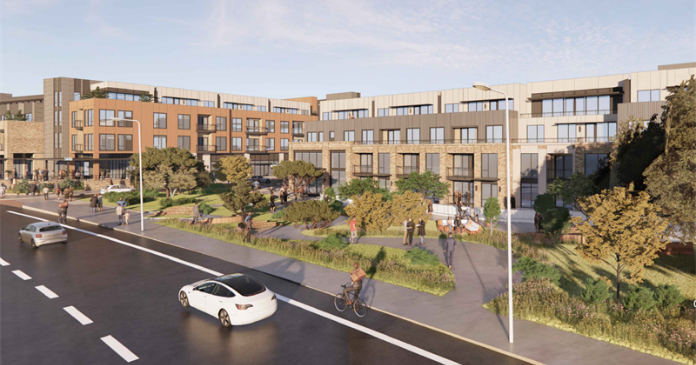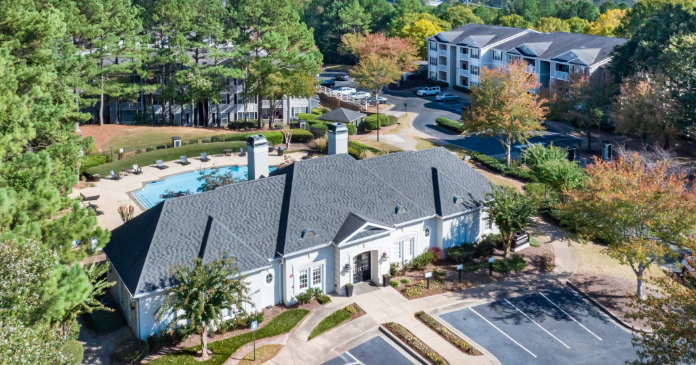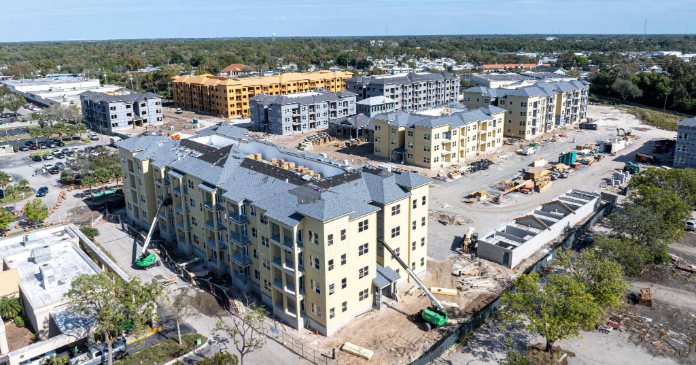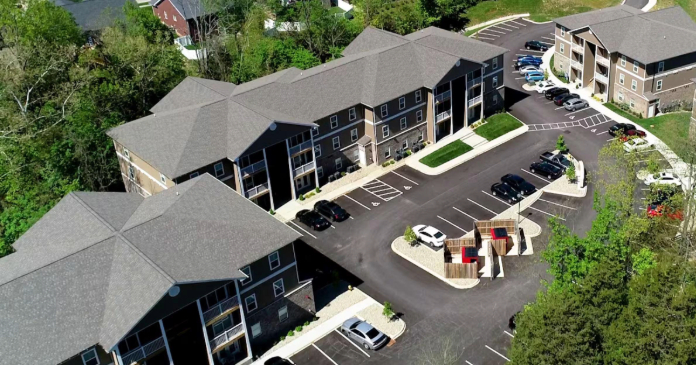Yield PRO TV presents NAHB Power Hitters. Host Linda Hoffman talks with Greg Anderson, SVP of Shea Properties.
Transcript: NAHB Power Hitters interview. Linda Hoffman with Greg Anderson, recorded August 26, 2021
(music)
Linda Hoffman: We’ve had quite a couple of weeks up here on the mountain. Today I speak to you from the beautiful Sierra Nevadas—a great place… that is when you can see it.
The air quality index, on a scale of 0 to 500, has been a choking 500. We’ve been smoked out by the Northern California Caldor fire, which at the time of recording has wiped out over 126 thousand acres of California land and real estate. Last report, the blaze was less than 20 miles from our Nevada studios with a steady breeze blowing our way. What’s the saying: as goes California, so goes the nation. Let’s hope not.
In fact, California has been a steady stream of news on many topics, but especially housing. A couple weeks ago we had the fortune of speaking with the great Greg Anderson of Shea Properties. Shea is a legendary developer-owner in the Western U.S. The company is known for many great accomplishments, but mostly its fearless development and ownership in places with high barriers to entry. Let’s say they like a challenge.
Back by popular demand, Greg—thank you for joining us.
Greg Anderson: Thank you for having me and thank you for that kind introduction, Linda.
Linda Hoffman: It’s great to see you again, Greg. There’s so much going on so let’s just dive in. In January 2020, California’s rent cap law, AB1482 took effect. Under this and other legislation, new housing units are exempt from rent restrictions for the first 15 years. Do the looming rent caps guide decisions about which projects to pursue?
Greg Anderson: Well, not yet. I think that when you talk about different properties, whether you’re talking about purchases versus development. On the development side, the 15 years is a large enough range that it has not yet impacted new development.
Typically, the financing—your first financing terms are for 10 years, and this is well beyond that, so, people can build their projects. They can stabilize them. They can get their long-term financing in place. They can sell them if they choose to or just continue to own them and they’re undisturbed at this point by 1482.
I think also, the first reaction to this bill is 5 percent over CPI (Consumer Price Index) right now is currently 7 percent. The historical rent range in Southern California for our portfolio over the last 10 to 20 years has been about 3.5 percent a year. Northern California 4.5 percent. So, there’s a little room there, yet. So, it has not caused a lot of concern, but it does impact people. On the buying side, I think it’s fair to say that there are other people who have the option of looking at other geographic areas of the country, or are looking in different locations that have less risk of this type of rent control law. You see more activity in places like Idaho, Nevada, Arizona and obviously the southeastern states. So, I think that that is affecting it.
But it has not affected us. We continue to move forward with our pipeline pretty much undisturbed at this point.
Linda Hoffman: Will the 15-year grace cause developers to favor new development over reno and value add assets?
Greg Anderson: As you mentioned, 1482, fixed properties, 15 years and older with a 5 percent plus CPI, or 10% cap. It also has it Just Eviction clause. The Just Eviction clause means you cannot refuse to renew a lease. So, that can affect people that are doing rehabs.
The option that you do have on the 1482 is to pay one month’s rent, and then you could release a person from the lease. And that way, we have folks that can move forward with their plan. And although it adds an additional cost, I think it will continue to work and it is still financially feasible. Because once you once you redo the unit, you’re able to mark to market, so, they can still get their yields.
They may be a little bit affected with the added month that they have to pay, but I think that you’re still seeing people continue to do rehab and it’s still going to be effective.
The demand is huge so you’re going to continue to see people in the rehab market.
In development—the development margins still work at the 15-year grace period. It makes sense, as I mentioned earlier. You have enough time to be able to effectively do your developments. So, I see both development and rehab continuing in California.
Linda Hoffman: So, properties where rent control is about to kick-in: Sell or hold?
Greg Anderson: We hold. Thus far, we’re a build and hold company. Our approach to this business is not to buy properties, but to build them and hold them. So, we are very reluctant to let go of our portfolio.
Obviously, we’ve owned properties for a very long time. We’ve depreciated them. There’s a very low tax basis. It’s a huge disincentive to sell at this point. But, we’re still managing the process.
We do have an added problem that emerges out of 1482 and that is, under normal program, we lease the properties, and our lease states that the end of the lease, you can terminate and move on—or you can go month-to-month if you haven’t decided that you want another long-term rental agreement be it 9 or 15 months. And, a lot of people are opting for month-to-month right now. And that is because we’re not charging a premium for month-to-months. This is because of 1482 and the COVID rebound.
Right now, our properties have a 13 percent lost-to-lease, which means the new rent is 13 percent higher than the rent of the people that are currently in the building because the rents dropped during COVID. Well, we’re only allowed to increase the rent by 7 percent. So, on those numbers it’s going to take us two years to recover, even though the market is already back because we’re limited.
Normally, we would charge say 4 or 5 percent, whatever the rent increase might be for another lease, and we would charge a much higher renter if you choose to go month-to-month as a disincentive. Yes, it gives you the flexibility—but we want to incentivize you to make a decision. That’s not happening. Normally, we have 2 to 5 percent month-to-month. We’re going as high as 12 to 15 percent. And the problem with that is we like to stagger our leases so that we have a certain number of vacancies each month. When you start getting to 15 percent month-to-month, then suddenly all of them can choose to leave your property at one time creating a very large vacancy.
So, that that’s a big problem that’s beginning to develop. And, we don’t know how it’s going to manifest. We’re looking into potentially not offering month-to-month, but we’re not certain that the state is allowing that. So, it’s complicated. So, that’s a little bit unclear for us so far, but we’re working our way through it. And that could be a big impact on long-term hold, but I think the bigger impact on long-term hold is if we go into an inflationary period in this 5 percent over CPI with a 10 percent max could start becoming a real problem if we start seeing 1970s-style inflation. But, it’s not there, yet.
So, although we have that problem, we’re still able to rehab our properties, to mark the market, and besides the increase month-to-month, we’re managing it pretty well. It’s taking longer to come back to trendline, but that’s just where we are right now.
So, I’m comfortable, but it’s not causing us to choose to sell our assets.
Linda Hoffman: What a great communicator, Greg. That’s a wonderful explanation.
Greg Anderson: Thank you. Thank you.
Linda Hoffman: California rent caps are CPI plus 5 percent. That’s a pretty loose cap. But now with rent control, the cap can be adjusted at any time. How do you factor the risk of a tighter cap into your development decisions?
Greg Anderson: Increasing or decreasing that number above CPI—I don’t see that happening. Look. The state needs a lot of housing. I think they felt they needed to lead the parade on some kind of rent control. They think Oregon beat them to the punch. California legislature does not like to get beat to the punch on these types of things. Oregon wanted 7 percent, but, by golly, California went to 5. There, they showed them, boy. But, they’ve done it. And I think that’s done. It’s very unlikely, in this potentially inflationary environment that we’re living in right now, I think it’s very unlikely to see that 5 percent move.
And I really, really, sincerely doubt that the 15 year will move. I think that even the people who most want to push for these types of rent control realized that if they shut down developments, they’re going to have a massive problem on our hands. Bigger than they already have, which is pretty massive. So, the 15 years is very likely to stay in place. I don’t think 1482 is the major impediment to development in the state. If they dropped it below 15, it could become that, but I don’t see that happening.
Linda Hoffman: Add to the statewide rent cap law, a patchwork of local rent control laws across the state. Does this cause you avoid certain communities… or do you just build in higher rents to make up the loss?
Greg Anderson: Well, you can’t just build in higher rents. You can start higher rents, but that’s going to take you through the first rent cycle, and then you’re going to be right back into that situation, again.
Yes, we avoid communities that have Draconian rent control laws, especially if they in any way affect new product, we will not get near them. Some people have the fortitude to do that. That’s just not in our DNA. We just don’t go there. Fortunately, most counties in California don’t have that added blanket of difficulty, so, there are a lot of places for us to go. But, we would avoid that, yes, absolutely.
Linda Hoffman: California’s vast tangle of regulation and laws have created one of the highest costs of development in the country. These include urban growth boundaries that limit the land that can be developed, CEQA, the California Environmental Quality Act—just to name a few rules targeting developers. And they wonder why there’s a housing shortage, along with rising cost.
Will California lawmakers ever correlate the cost of regulations with lack of—and ultimately rising cost of housing?
Greg Anderson: Sacramento has been trying for years. Sen. Scott Weiner, San Francisco, has floated different bills. Almost every year, they get pretty far down the line and then they either get squashed or they throw something very unreasonable at it, like okay, you could do it, but you have to use union labor—which, of course, drives the cost to a place where we can’t build. So, it’s like okay. That is a good idea, but it’s not going to work.
So, they’ve been trying very hard for many years. There are a lot of forces at work in Sacramento that oppose this kind of stuff. Gov. Newson came into office promising 3.5 million new housing units by 2025. I think that would be 700,000 a year. What have they built? I think about 110,000 a year. So, you know, California has to double, or more than double, the amount of housing that they build for the next 10 years just to keep up with growth. Do I see it happening? No.
There are attempts coming out of Sacramento, but they’re not taking hold in a way that’s making a big difference. You know the contributors to the cost of development—you mentioned CEQA, the Environmental Quality Act. It causes a lot of land scarcity because between CEQA and other government limitations, we have very little land. We got NIMBY-ism which causes most councils to vote projects down regardless of whether CEQA even gets involved, which, again, further limits land, pushes prices up.
Construction costs are ever-increasing. We want to make our environment better. We want to reduce carbons. We want to do a lot of things that environmental pushes. But all those increase the cost of construction, which make it more difficult to build.
And, then cities have a tendency to want to charge the residential projects for the infrastructure impact. So, we have huge fees. Fees in California can range from as low as $15,000 a unit, to upwards of $115,000 to 120,000 a unit. And those are expensive. They go right back to the bottom line. So, Sacramento has a long way to go. I have not seen anything come out of them that’s going to make enough of a difference.
Just let me frame the problem a little bit. There are, I’ve read differing numbers. But let’s just say between 5.5 and a 7 million housing shortage in the United States. From 1968 to 2001, we were building about 1.5 million homes. Since 2001, we’re building about 1.2. So, we’ve been building a deficit into it… in the country.
California represents somewhere between 3 to 4 million of that 5.5 to 7 million deficit. So, the majority of the national problem is in California. California, in the Bay Area, adds about seven jobs for every one housing unit. The state of California adds five jobs for every one housing unit. The councils love those jobs because it offers prosperity, but then they want to charge the housing units for the infrastructure needed to accommodate those jobs.
So, you know, it’s a big problem. The arguments are about protecting the rights of homeowners and stopping those greedy developers. It’s rarely about what the developers are building—to allow it to somebody other than those homeowners to own a home or rent a property at a reasonable rate. But they turn the argument around and it’s always about greedy developers. The reason our profits go up is because they don’t allow any product and, therefore, we get huge rent growth and huge property escalations.
We proved in the 1980s that if you let the development community, we will overbuild and rents will go down, and property values will moderate, and there will be affordable housing in the future. But, unfortunately, that’s not the discussion that we’re hearing in California right now.
Linda Hoffman: Governor Newsom supports building housing on surplus state land. Could this make a difference in California’s housing, or is it too late?
Greg Anderson: I don’t know if it’s too little too late. I don’t know if surplus land is going to be enough to make a difference. You know, the cities are paying attention to that, because if they don’t do it properly, the state will sue them.
We were working on a property where we did have an agreement with the city, and the city said, “Well, it used to be surplus land.” And we said, well, yeah, but it isn’t now because you’re under contract with us. And, so, we worked our way through it. But it clearly pointed out to us that cities take very seriously the idea of focusing on the surplus land, and first allowing it to be offered up for affordable housing.
I think that’s great. I think that any kind housing—we need it and I’m fully supportive of it. I don’t think it’s enough to move the needle. But it certainly sounds good. You know, in the state of California, every five years, all cities need to update their housing element. And their housing elements requires that they point to land that is, or will be, zoned for housing to accommodate all housing needs in that community.
The state allocates that housing need to each one of these cities. Well what we’ve come to find our is that many cities are picking a number of tracts of land and saying, here are the properties that will accommodate this housing requirement, and they’re making them 100 percent affordable. Well, you can’t build all 100 percent affordable. We don’t have the ability under market conditions to do that. So, what that does is it enables councils to allocate far less land than is necessary, if, let’s say all the properties were allocated for 20% affordable—we’d need five times more land. That would cause a lot of political problems for counsels, so they’ve been directing their staff to do this one-hundred percent affordable approach. And it feels like it’s a circumvention of the process. It is unfortunate because it’s a very serious issue, and we really, really need to allocate housing. We need councilmembers to communicate to their constituency that if we don’t do this, we will have much more serious problems on our hands. So, there’s a lot that needs to be done, and a lot of it is being met with a lot of resistance.
Linda Hoffman: Shea develops Class A, Greg. Have you considered workforce housing or is that not possible in California without a subsidy?
Greg Anderson: We would love to build workforce housing. I mean, you know, you’d probably have even lower vacancy rates. You would have an endless demand for your product. In the urban, or quasi urban areas, it is financially impossible. At some point, subsidy or tax credit or something else, but, of course workforce housing doesn’t have a tax credit opportunity, so, it’s more affordable than that.
But, yeah, we would like to do it and we can’t do it. Maybe in some of the more remote parts of California you might be able to do that, but that’s not where we typically invest. I think you’re seeing a lot of other companies that have a more national footprint… are pursuing workforce housing in other states because they could do it. And they find it attractive and they’re doing a lot of it. I think there are a lot of funds out there today that are specifically for workforce housing, but I have not heard of a lot of those funds allocating capital in California.
So, we’d love to do it, but, unfortunately, we haven’t figured out how to do it.
Linda Hoffman: Well, since you have no problem hitting the hardballs in this interview—Eliminating single-family zoning—characterized as “exclusionary” zoning in some circles—has been touted as the solution to the housing shortage. Two bills in the California Legislature would do that: SB9 and SB10. Both bills are opposed by those behind the recent rent control initiatives. They want the legislated infill housing to also be mandated as “affordable.”
Their logic is more housing, without displacement, and oh yeah, doesn’t the impact to surrounding housing cause gentrification? Is California doomed?
Greg Anderson: I don’t think it’s doomed. Before I answer the doomed part, you’ve got to remember California has one of the most incredible human resources capital of any state in the country. It’s probably, what, the seventh largest GDP in the world. I mean it’s a powerful state that has a lot going for it. But this is a problem. At some point, it could stop the wonderful fairytale of California’s growth, but not yet.
SB 9 and SB 10, I think they passed the legislature. They’re heading back to the Senate for confirmation, and they’re going to the governor’s desk. So, let’s see what happens. Yes, you are correct. The same people who put out Prop 10, which was later Prop 21, with an attempt to put in a very Draconian rent control law throughout the state. And if it was voted and it’s even more difficult to ever remove. But, it was soundly beat both times by about 60 percent of the vote. In fact, I think Proposition 21 actually had slightly more no’s than Proposition 10. But the AIDS foundation was behind that and is, again, behind this No on 9 and 10.
There’s another group called, Housing is a Human Right. That concerns me a great deal. I guess it’s not property rights anymore, it’s now a human right. So, they’ve obviously got some very big legal challenges to take their title all the way to law. They claim the problem with SB 9 and 10 is that it doesn’t mandate affordable housing, but what it does do, is it enables people—SB 9 enables people to have a single family lot if they want to redevelop that lot they can put in a duplex, or maybe even as much as a 4-plex. SB 10 allows people to build up 10 units without having to go through CEQA if they are within a specified urban area, or in transit hub.
So, it seems to be innocuous, even if they pass unfettered it’s not going to solve the problem. But, it’s, you know, it’s something that that the smaller developer, the non-institutional developer could help with the problem, individuals might. But, yeah, the claim seems to be that that building more housing won’t work, as they site the trickle down theory doesn’t work, and they site the fact that, look at how much development there’s been in the state of California, but rents keep going up.
What they failed to mention is that the amount of development that goes on California, although quite a bit, still does not meet demand. And unless supply exceeds demand, you’re not going to see rents come down. You’re going to see them go up. So there’s not an opportunity for the free market to solve problem. But that’s not the way the advocates characterize the issue.
You know, and then you have the issue of gentrification, which is a real one. There have been problems with gentrification and where people have been thrown out, and I think that a lot of planning departments have failed to take advantage of an influx of capital into a neighborhood, and manage it in a way where there’s a balance of affordable housing along with market rate housing.
The good news about market rate housing is it brings in other retail. It brings in food. It brings a lot of benefits for that neighborhood. And if you can plan in America, you maintain affordable housing balances in those neighborhoods by using density, you can create win-win situations. But, that kind of planning has not happened, and unfortunately gentrification is a really bad thing because of it.
It’s a problem. We’ll see if SB 9 and 10 pass—I hope they do. We need everything we can get, but the big plight that I see in California is the continued battle at the local level for local control over the zoning. And, the threat from the state that if you don’t start solving the problem, the state is going to take over zoning. And, that obviously, it’s scary for somebody from Sacramento to determine the zoning of something right across the street from you, or right down the block from you. But at the same time, I do not see how a counsel can remain in office, because the disdain for development is enormous.
People don’t realize the negative impact economically that will happen if we don’t solve the problem of housing. So, the big dilemma is going to continue with us. We’ll have to figure out a way to get through it. I expect that if we’ve going to solve it, there’s going to be a lot of development in California going forward.
Linda Hoffman: Well, another great show. Greg, California has long been a challenge for developers and landlords. Thank you for helping us sort through some of the most pressing issues.
Greg Anderson: Well, thank you. Thank you for having me and I hope I offered a little bit of clarity on some of these issues.
Linda Hoffman: Great show.
Greg Anderson: Thank you.
Linda Hoffman: Today’s news cycle is like drinking from a fire hose. Leading the news is both multifamily with the eviction moratoriums, lack of housing, and rising rent control… and front and center is the state of California. As goes California, so goes the nation? Some things are better left where they are.
Thanks for joining us. I hope you enjoyed our show. I’m Linda Hoffman. See you on our next exciting episode of NAHB power hitters.












